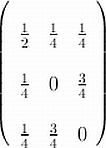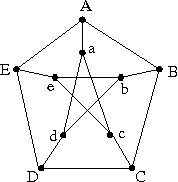Board problem: Write the doubly stochastic matrix

Bonus question: Prove that no permutation matrix is the convex combination of other permutation matrices.
The date of our second test was moved up to Tuesday November 15. We will review on Thursday November 10. You may download the Sample Test 2 I distributed in class on Thursday November 3.
Note: While working on the exercises in section 4.2, you may want to revisit the Java applets simulating Kruskal's algorithm and Prim's algorithm (by Kenji Ikeda).
Bonus problem: Explain how Floyds algorithm (see p. 129 in our textbook) works. In particular what is the role of the variable k?
Note: While working on the exercises in section 4.1, you may want to revisit the Java applets simulating Dijkstra's algorithm (by Kenji Ikeda).
Bonus problems:
- How can you find the degree of a vertex using the adjacency matrix? (Justify your answer.)
- Find and prove a formula for the chromatic polynomial of a circuit Cn of length n.
Note: 2.4/8a has a typo. The correct inequality is:
 .
.
Our first test is on Tuesday September 27. You may downloand the Sample Test 1 I distributed in class on Thursday September 22.
Bonus problems:
- Show that allowing disconnected countries no fixed number of colors suffices to color all maps.
- Prove Grinberg's theorem.
Board problem: The Petersen graph is shown in the picture below.

Bonus problem (2pts), expires when this assignment is due: Find the theorem in the book (page number, theorem number) stating the number of edges of a tree.
Bonus problem: Prove that the edge graph of the n-dimensional hypercube is bipartite. (The vertices of the n-dimensional hypercube are all 01-strings of length n, two vertices are adjacent when exactly one of their coordinates differs.)